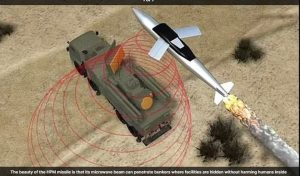US Air Force Secretly Develops Missiles That Can Obliterate Iran’s Nuclear Sites


Ronald Kessler, a former Washington Post and Wall Street Journal investigative reporter, is the New York Times Bestselling Author of ‘The Secrets of the FBI,’ ‘The First Family Detail,’ and the ‘CIA at War.’
The US Air Force has quietly deployed missiles that could destroy the electronics of Iran’s nuclear facilities with high-power microwaves, rendering them useless, without causing any fatalities, DailyMail.com has learned exclusively.
Known as the Counter-Electronics High Power Microwave Advanced Missile Project (CHAMP), the missiles were built by Boeing’s Phantom Works for the US Air Force Research Laboratory and first tested successfully in 2012. They were deployed—meaning installed in various locations around the globe—and became operational in 2019.
This comes as Israel has conducted strikes in Iran in retaliation for Tehran’s unprecedented drone-and-missile assault earlier this week, defying US President’s warning that more attacks could plunge the Middle East further into conflict.
Mary Lou Robinson, then chief of the High Power Microwave Division of the Air Force Research Lab at Kirtland Air Force Base, previously confirmed to DailyMail.com that 20 CHAMP missiles were operational and ready to take out any military target, including nuclear facilities.
When asked for comment, Othana Zuch, an Air Force Research Laboratory public affairs officer, said that while ‘operational security precludes us from discussing specific operational applications for our technologies,’ the CHAMP missiles were considered a demonstration program and ‘we have since continued to develop advanced HPEM (High Power Electromagnetic) technologies’ building on the original demonstration.
The microwave weapons are fitted into an air-launched cruise missile and delivered from B-52 bombers. With a range of 700 miles, they can fly into enemy airspace at low altitude and emit sharp pulses of high power microwave (HPM) energy that fry computer chips, disabling any electronic devices targeted by the missiles without causing any collateral damage.
The missile is equipped with an electromagnetic pulse cannon. This uses a super-powerful microwave oven to generate a concentrated beam of energy. The energy causes voltage surges in electronic equipment, rendering them useless before surge protectors have the chance to react.
The project has been advancing secretly ever since the Air Force successfully tested a missile equipped with HPM in 2012.
In the test, the CHAMP missile flew over a two-story building on the Utah Test and Firing Range.
The building in the west Utah desert was crammed with computers and security and surveillance systems. The microwaves took down the compound’s entire spectrum of electronic systems, including video cameras set up to film the test, without damaging anything else.
‘We hit every target we wanted to,’ Boeing’s CHAMP Program Manager Keith Colman said in a company press release then. ‘Today we made science fiction into science fact.’
Until the announcement of the successful test, the project had been top secret. When it was announced, only a few trade publications ran the story.
Since then, beyond several dozen stories in December 2017 when the missiles were still non-operational, the media beyond DailyMail.com have ignored the story.
Because of sequestration budget cuts, the CHAMP missiles did not become operational under the Obama administration.
But after I emailed then Trump National Security Adviser H. R. McMaster in August 2017 information about CHAMP that I was about to include in my book ‘The Trump White House: Changing the Rules of the Game,’ McMaster thanked me for letting him know about the capability which he was not aware of, agreed to an interview, and ordered a briefing from the Pentagon.
As a result, the Pentagon funded the program and ordered Air Force training worldwide to deploy and operate the missile systems.
The beauty of the HPM missile is that its microwave beam can penetrate bunkers where facilities are hidden without harming humans inside.
Even if a bunker is buried in a mountain, HPM penetrates the facilities through its connections to power cables, communication lines, and antennas. Thus, HPM can penetrate any underground military or nuclear facility and destroy its electronics.
Targeted at command and control centers, the missile could render any country’s military inoperable. And one missile can hit multiple targets in succession.
While Iran may attempt to shield its equipment, US officials say that would not be effective against the HPM missiles.
Besides underground bunkers and command centers, HPM can quickly disable fighter planes, tanks, ships, and missile systems. And it can wipe out facilities for developing and testing nuclear weapons.
America’s national laboratories operated by the Department of Energy have been working on HPM capabilities for decades. Over the years, HPM devices have been deployed on the ground in Afghanistan and Iraq to disable improvised explosive devices (IEDs) and drones.
The HPM missiles are entirely different from cyber-warfare designed to confuse computers. Unlike a cyberattack, they permanently fries electronic equipment.
HPM missiles also differ from an electromagnetic pulse (EMP) attack that is created by detonating a nuclear weapon in the atmosphere. Because it is targeted, HPM leaves intact civilian facilities needed to sustain life.



